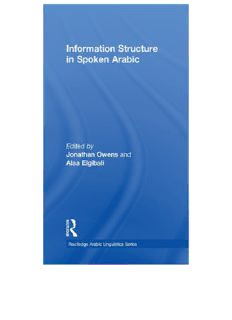
Information Structure in Spoken Arabic PDF
Preview Information Structure in Spoken Arabic
INFORMATION STRUCTURE IN SPOKEN ARABIC This book explores speakers’ intentions, and the structural and pragmatic resources they employ, in spoken Arabic—which is different in many essential respects from literary Arabic. Based on new empirical findings from across the Arabic world this book elucidates the many ways in which context and the goals and intentions of the speaker inform and constrain linguistic structure in spoken Arabic. This is the first book to provide an in-depth analysis of information structure in spoken Arabic, which is based on language as it is actually used, not on normatively given grammar. Written by leading experts in Arabic linguistics, the studies evaluate the ways in which relevant parts of a message in spoken Arabic are encoded, highlighted or obscured. It covers a broad range of issues from across the Arabic-speaking world, including the discourse-sensitive properties of word order variation, the use of intonation for information focusing, the differential role of native Arabic and second languages to encode information in a codeswitching context, and the need for cultural contextualization to understand the role of “disinformation” structure. The studies combine a strong empirical basis with methodological and theoretical issues drawn from a number of different perspectives including pragmatic theory, language contact, instrumental prosodic analysis and (de-)grammaticalization theory. The introductory chapter embeds the project within the deeper Arabic grammatical tradition, as elaborated by the eleventh-century grammarian Abdul Qaahir al-Jurjaani. This book provides an invaluable comprehensive introduction to an important, yet understudied, component of spoken Arabic. Jonathan Owens is Professor of Arabic Linguistics at Bayreuth University, Germany. He has published extensively on many aspects of Arabic linguistics; his most recent publications include Arabic as a Minority Language and A Linguistic History of Arabic. Alaa Elgibali is Professor of Arabic and Linguistics at the University of Maryland, USA. He is the author of several seminal publications, including Arabic as a First Language: A study in language acquisition and development, and is associate editor of the four-volume Encyclopedia of Arabic Language and Linguistics. ROUTLEDGE ARABIC LINGUISTICS SERIES General Editor: Clive Holes University of Oxford Editors: El-Sa’id Badawi American University in Cairo Adrian Gully University of Melbourne Yasir Suleiman University of Cambridge Keith Walters University of Texas The Routledge Arabic Linguistics Series publishes high-quality, academically rigorous research on Arabic linguistics to two main readerships: non-Arabist general linguists with an interest in Arabic, and students and researchers already in the field of Arabic language and linguistics. Both synchronic and diachronic studies of Arabic are welcome which aid our understanding of the historical evolution and the present state of Arabic, whether dialectal or standard. Works written from a sociolinguistic (e.g. language variation), socio-historical (e.g. language history), sociological (e.g. language planning), or psycholinguistic (e.g. language acquisition) perspective are welcome, as are studies of Arabic stylistics, pragmatics, and discourse analysis. Descriptive dialectological works also fall within the scope of the Series, as do works which focus on the evolution of medieval Arabic linguistic thought. Proposals or scripts for the Series will be welcomed by the General Editor. Previously published by Curzon 1 MEDIEVAL ISLAMIC PRAGMATICS Sunni legal theorists’ model of textual communication Mohamed Mohamed Yunis Ali 2 JEWISH AND MUSLIM DIALECTS OF MOROCCAN ARABIC Jeffrey Heath 3 LANGUAGE CONTACT AND LANGUAGE CONFLICT IN ARABIC Variations on a sociolinguistic theme Edited by Aleya Rouchdy Published by Routledge 4 STRUCTURE AND FUNCTION OF THE ARABIC VERB Maher Bahloul 5 ARABIC IN THE CITY Issues in dialect contact and language variation Editedby Catherine Miller with Enam Al-Wer, Dominique Caubet and Janet Watson 6 INFORMATION STRUCTURE IN SPOKEN ARABIC Edited by Jonathan Owens and Alaa Elgibali INFORMATION STRUCTURE IN SPOKEN ARABIC Edited by Jonathan Owens and Alaa Elgibali LONDON AND NEW YORK First published 2010 by Routledge 2 Park Square, Milton Park, Abingdon, Oxon OX14 4RN Simultaneously published in the USA and Canada by Routledge 270 Madison Ave, New York, NY 10016 Routledge is an imprint of the Taylor & Francis Group, an informa business This edition published in the Taylor & Francis e-Library, 2010. To purchase your own copy of this or any of Taylor & Francis or Routledge’s collection of thousands of eBooks please go to www.eBookstore.tandf.co.uk. © 2010 Selection and editorial matter, Jonathan Owens and Alaa Elgibali; individual chapters, the contributors All rights reserved. No part of this book may be reprinted or reproduced or utilized in any form or by any electronic, mechanical, or other means, now known or hereafter invented, including photocopying and recording, or in any information storage or retrieval system, without permission in writing from the publishers. British Library Cataloguing in Publication Data A catalogue record for this book is available from the British Library Library of Congress Cataloging in Publication Data Information structure in spoken Arabic/edited by Jonathan Owens and Alaa Elgibali p. cm.—(Routledge Arabic Linguistics Series) Includes bibliographical references and index. 1. Arabic language-Spoken Arabic. 2. Arabic language-Discourse analysis. 3. Pragmatics. 4. Code switching (Linguistics) I. Owens, Jonathan. II. Elgibali, Alaa. PJ6161.154 2009 492.701'41–dc22 2008053673 ISBN 0-203-87583-4 Master e-book ISBN ISBN10: 0-415-77844-1 (hbk) ISBN10: 0-203-87503-4 (ebk) ISBN13: 978-0-415-77844-2 (hbk) ISBN13: 978-0-203-87583-4 (ebk)
Description: